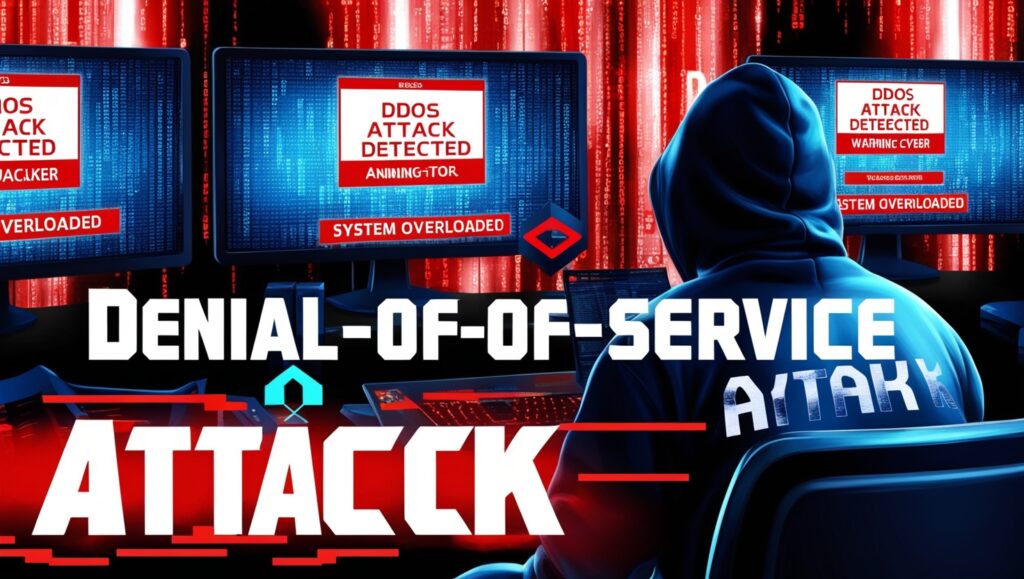1. Introduction to Denial-of-Service (DoS) Attacks
Denial-of-Service Attacks are among the most disruptive cyber threats affecting businesses and individuals worldwide. A Denial-of-Service Attack (DoS) is a malicious attempt to overload a network, server, or website with excessive traffic, rendering it inaccessible to legitimate users. These attacks exploit system vulnerabilities to disrupt services, leading to downtime, financial loss, and reputational damage.
Cybercriminals use Denial-of-Service Attacks to target organizations, government institutions, and even individuals. The primary goal is to exhaust system resources, making it impossible for users to access the services they need. In this article, we’ll explore how Denial-of-Service Attacks work, their types, detection methods, mitigation strategies, and legal consequences.

2. How DoS Attacks Work?
Denial-of-Service Attacks work by overwhelming a target system with a massive amount of requests or data packets, causing it to slow down or crash. Attackers leverage various techniques to flood a network or application, such as:
- Bandwidth Consumption: Attackers send excessive data to clog the network.
- Resource Exhaustion: Targeting CPU, memory, or database resources.
- Exploiting Vulnerabilities: Exploiting software weaknesses to force crashes.
These attacks do not necessarily require advanced hacking skills, as various tools make launching Denial-of-Service Attacks easier for cybercriminals.
3. Types of Denial-of-Service Attacks
There are several types of Denial-of-Service Attacks, each using different methods to disrupt services. The most common include:
3.1 Volume-Based Attacks
These attacks aim to consume all available bandwidth of a target.
- UDP Flood: Overwhelms a target with User Datagram Protocol (UDP) packets.
- ICMP Flood (Ping Flood): Sends a flood of ICMP Echo Request packets (pings).
- DNS Amplification: Uses vulnerable DNS servers to amplify attack traffic.
3.2 Protocol Attacks
Protocol-based Denial-of-Service Attacks exploit weaknesses in network communication protocols.
- SYN Flood: Sends a large number of TCP connection requests but never completes them.
- Ping of Death: Sends oversized or malformed packets to crash systems.
- Smurf Attack: Exploits ICMP responses to overwhelm a victim’s network.
3.3 Application Layer Attacks
These attacks target specific applications rather than the network.
- Slowloris: Opens multiple connections but sends data slowly, exhausting resources.
- HTTP Flood: Overloads web servers by making excessive HTTP requests.
- Zero-Day Attacks: Exploits undiscovered vulnerabilities in applications.
4. Difference Between DoS and DDoS Attacks
While both Denial-of-Service Attacks (DoS) and Distributed Denial-of-Service Attacks (DDoS) aim to disrupt services, there are key differences:
- DoS Attack: Originates from a single source, making it easier to trace and block.
- DDoS Attack: Uses multiple compromised devices (botnets) to launch an attack, making it harder to mitigate.
DDoS attacks are more dangerous due to their scale, often requiring specialized defenses such as DDoS mitigation services.
5. Common Tools Used for DoS Attacks
Several tools are used to launch Denial-of-Service Attacks:
- LOIC (Low Orbit Ion Cannon): A simple DoS attack tool.
- HOIC (High Orbit Ion Cannon): An advanced version of LOIC.
- HULK (HTTP Unbearable Load King): Generates massive HTTP requests.
- Slowloris: Used for slow, persistent attacks.
These tools highlight the accessibility of DoS attack mechanisms, making network security crucial.
6. Real-World Examples of DoS Attacks
- GitHub (2018): Hit by a massive 1.3 Tbps DDoS attack, causing downtime.
- Dyn (2016): A DDoS attack disrupted major services like Twitter and Netflix.
- Estonia (2007): Government websites were targeted by politically motivated attacks.
These cases show how devastating Denial-of-Service Attacks can be for large-scale organizations and even entire countries.
7. How to Detect a DoS Attack?
Detecting a Denial-of-Service Attack early is crucial to minimize damage. Common indicators include:
- Slow or unresponsive services.
- Increased network traffic and bandwidth consumption.
- Unusual spikes in CPU and memory usage.
- Frequent disconnections or timeouts.
Monitoring network traffic and using Intrusion Detection Systems (IDS) can help identify attacks in real-time.
8. Preventing and Mitigating DoS Attacks
Protecting against Denial-of-Service Attacks involves multiple layers of security:
8.1 Rate Limiting & Traffic Filtering
Limiting requests per second can help block excessive traffic from attackers.
8.2 Firewalls & Intrusion Prevention Systems
Configuring Web Application Firewalls (WAFs) can filter out malicious traffic.
8.3 CDN & Cloud-Based Protections
Cloud-based DDoS mitigation services can absorb attack traffic before it reaches the server.
8.4 Network Redundancy & Load Balancing
Spreading traffic across multiple servers prevents a single point of failure.
9. Legal Consequences of DoS Attacks
Engaging in Denial-of-Service Attacks is illegal in many countries and can lead to severe penalties:
- United States: Computer Fraud and Abuse Act (CFAA) enforces strict penalties.
- Europe: The EU Cybercrime Directive criminalizes DoS attacks.
- India: The IT Act, 2000 penalizes cyber-attacks, including DoS.
Perpetrators face hefty fines and imprisonment, highlighting the serious nature of these attacks.
10. Conclusion & Best Practices for Protection
Denial-of-Service Attacks are a growing cybersecurity threat that can severely impact businesses and individuals. By understanding how these attacks work, the different types, and how to detect and prevent them, organizations can better protect their systems.
To stay safe:
- Implement robust network security measures.
- Use DDoS protection services.
- Regularly monitor traffic patterns.
- Educate employees on cybersecurity best practices.
By taking these precautions, you can minimize the risk of Denial-of-Service Attacks and ensure uninterrupted service availability.
Read More Blog:- https://thetechcrime.com/api-rate-limiting/
Check More Blog:- https://www.youtube.com/@Thetechhacker231

Leave a Reply